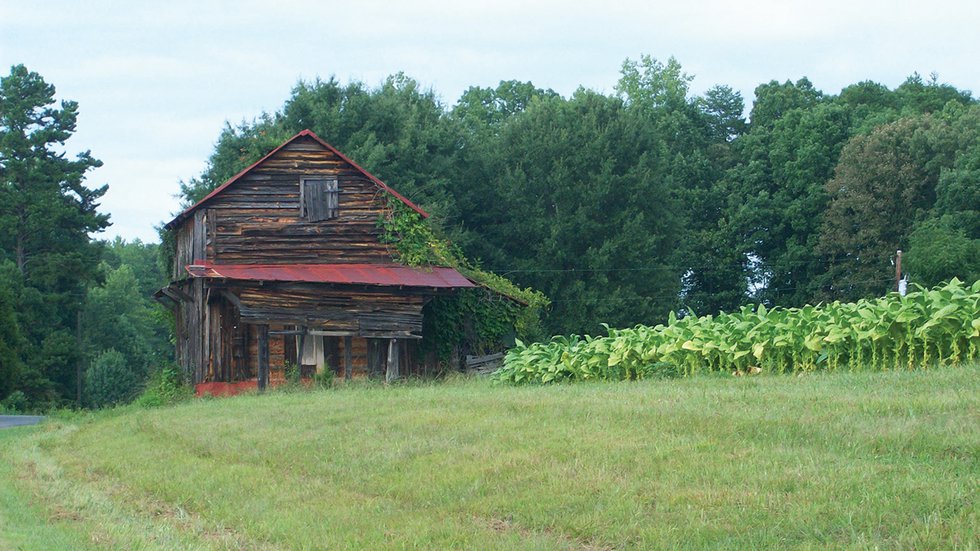An effort to protect Pittsylvania’s remaining tobacco barns is as much about honoring a way of life as it is about preserving the history of the industry.

Tobacco Barns
In flue curing, metal pipes channeled heat into the barns without exposing the leaves to smoke.

Tobacco Barns
Life centered around the grower’s barns during the curing season in August and September.

Tobacco Barns
Tobacco still grows in Pittsylvania County, but it is no longer cured in the wooden barns that symbolize traditional Southside life.
The sun still beats on the old tobacco barns of Pittsylvania County. Rain still patters on tin roofs. Wind still blows around the edges of plank doors. But the smell is different. For a hundred years, from the rise of bright-leaf tobacco after the Civil War until the 1970s, the rich aroma of curing tobacco filled the barns every August and September. Now there’s just the earthy smell of dirt and weeds.
The sound is different, too. During the curing season, each barn was filled with the voices of men, women and children, owners and tenant farmers, white and black, tying leaves together and hanging them in the barns where they would cure for three to five days. Some 26 million pounds of tobacco was produced in the county in 1965 during its heyday. Most was shipped to Danville to be auctioned to companies including R.J. Reynolds, Philip Morris, Liggett & Myers and American Tobacco.
Now, the barns stand silent along the back roads of Pittsylvania’s rolling piedmont. Poison ivy and wild grapevines creep up the sides. Many are falling victim to the erosive forces of cold and heat, wind and water.
Unless something is done, these relics of the county’s heritage may disappear like a puff of smoke in the wind. That’s the message of Preservation Virginia, which is spearheading a project to save the estimated 1,000 tobacco barns that remain in Pittsylvania County.
“Bright-leaf tobacco shaped the landscape, shaped the culture and the people,” says Sonja Ingram, who is leading the project for Preservation Virginia. “The entire family would work in tobacco. Out in the rural areas, the only thing that’s left are these barns, so we want to keep them in the landscape. They’re beautiful, they’re picturesque.”
Volunteers from local historical societies have surveyed the barns, documented architecture and condition, taken photographs and collected old snapshots and oral histories. The barn survey covers Pittsylvania County, but the collection of memorabilia includes adjacent counties.
To fund the production of the book and cover the costs of the project, Preservation Virginia looked to grants from private foundations, says Ingram, a former archaeologist and Danville’s field representative for Preservation Virginia. Grant money may also be used to help barn owners carry out repairs, such as roof work, needed to keep the barns from disintegrating.
At the height of the tobacco industry, there were probably 5,000 to 6,000 barns in Southside Virginia, Ingram says. She believes most of the surviving barns were built between the 1860s and the 1940s. “One thing we want to do is actually get a handle on the dates of the barns,” she says.
Growing “baccer” was (and is) a complicated process. The tobacco year began in February or March, when plant beds were sown with tiny seeds. In May or early June the seedlings, called “slips,” were “drawn” by hand from the plant bed and transplanted into “hills” in the field. In July the plants were “topped” to force vitality into the leaves rather than flowers and seeds.
Leaves were harvested four or five times, in August and September. Men pulled them by hand, four or five leaves from each plant. Leaves were tossed into slides (open wooden crates) and dragged by mule or tractor to the barn. At the barn, workers strung several leaves together at the stalk and hung the bundled leaves from loose “sticks” like tomato stakes held horizontally. The sticks were then set on tier poles that crossed the width of the barn: There might be six levels of tier poles. Boys climbed with sticks into the upper reaches.
After a day of pulling and stringing, hands would be black. “That tar gets on you,” says Stephen Barts, county extension agent and fourth-generation tobacco farmer. “It’s black as soot … sticky.”
Next came curing, the application of heat to dry the leaves and bring out the color and flavor. Born and raised on a tobacco farm outside Danville, 78-year-old Leon Compton says the process took three days at his farm; other farmers took a little longer.
But curing tobacco wasn’t all work, according to an exhibit at the Prizery, a former tobacco processing facility in South Boston. It was also a social event. On late summer evenings, neighbors gathered at the barn for watermelon, Brunswick stew, corn, apples and roasted potatoes.
On the first day of curing, the barn was heated to 115 degrees, says Compton. The leaves yellowed from the bottom up. Heat was increased gradually to ensure a uniform color. “After you got it to where you wanted the color, you went up on your heat to ‘set’ the color,” he explains. On the third day, the heat was increased to 175 or 180 degrees, to “kill out” the sap from the stem.
“They cured by feel and touch,” says Barts. “It’s kind of a lost art.”
By the 1970s, “stick barns” were falling into disuse, replaced by prefabricated metal bulk curing barns that look like shortened semi-truck trailers. Racking machines eliminated hand stringing. “You got so much more capacity with so much less labor,” says Barts. Metal barns are immune to the fires that destroyed many stick barns.
Despite increasing regulation of the industry, and growing awareness about the health risks of smoking, tobacco is far from dead in Pittsylvania County. It is still the leading crop, with around $25 million in sales in 2011. But acreage and production are down from 20th-century peaks, and it is no longer a family-centered way of life. There are only eight or 10 tobacco farmers under 35 left in the county, according to Barts. Most tobacco farmers are over 55. Today, most labor comes from Latin America.
The barns are perhaps the most tangible reminder of the golden leaf that was, and is, many things to many people in Pittsylvania County—the plant that built Danville’s stretch of Victorian mansions on Main Street called Millionaire’s Row, and put food on the table and money in the bank for working people.
While tobacco consumption in the U.S. is declining, perhaps there’s a new way for tobacco to contribute to the county’s economy, says Ingram, who points out that tourism is the second largest industry in Virginia.
“This region doesn’t have a very organized heritage tourism initiative. We think those tobacco barns are what define this area. It could be the beginning or the lynchpin to a heritage tourism effort in this region and could really help the local economy. We could have driving trails all over the place linking the really nice barns with the tobacco warehouse district.”
Ingram’s vision has sparked interest from more than 100 people, including a number of barn owners, who have volunteered to help Preservation Virginia—evidence that people want to preserve the old traditions.
Tobacco was so important to these communities, says Barts, that “even if just one leaf fell off the trailer, you stopped to pick it up.” PreservationVirginia.org
This article originally appeared in our October 2012 issue.










